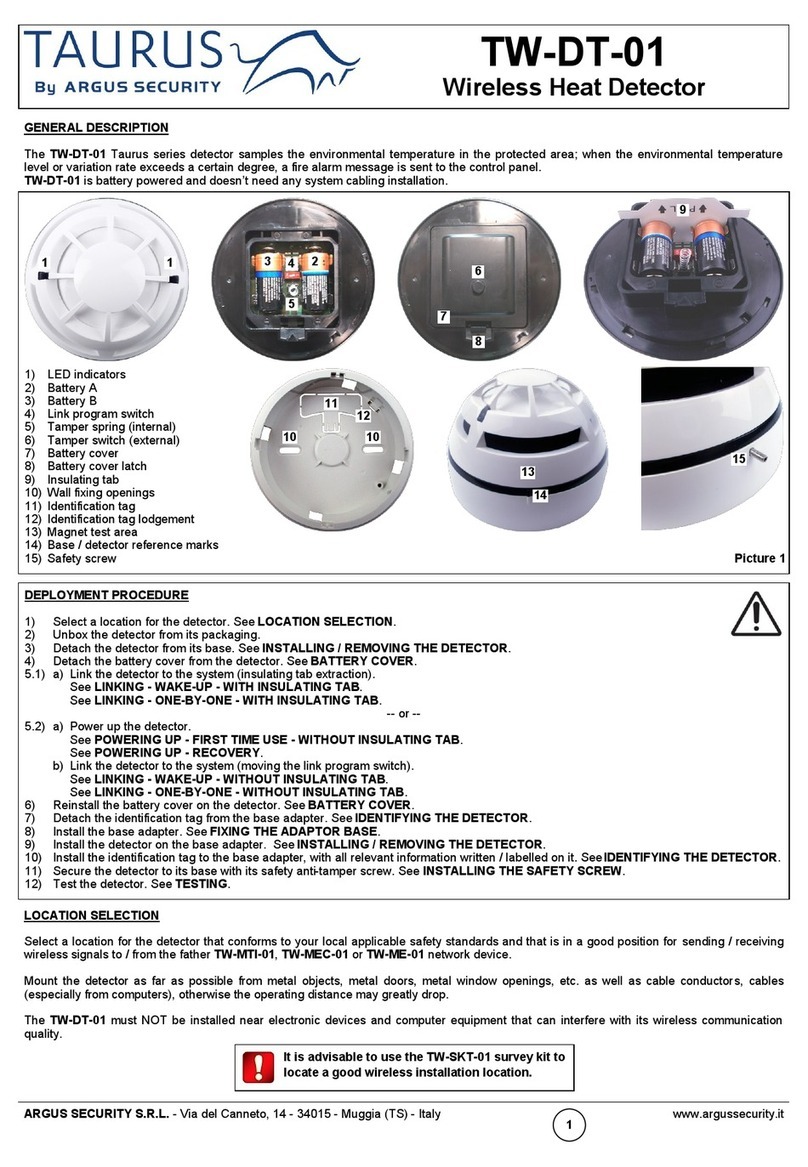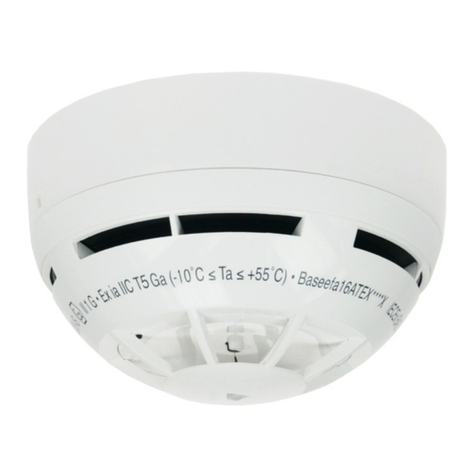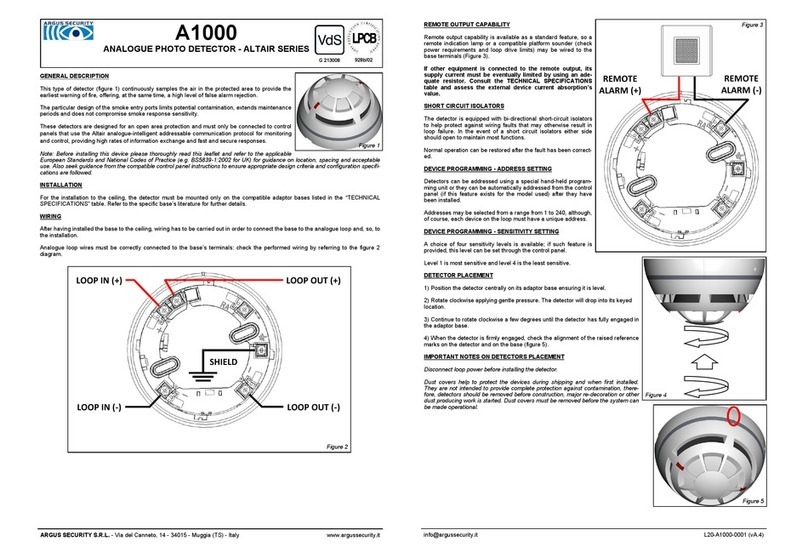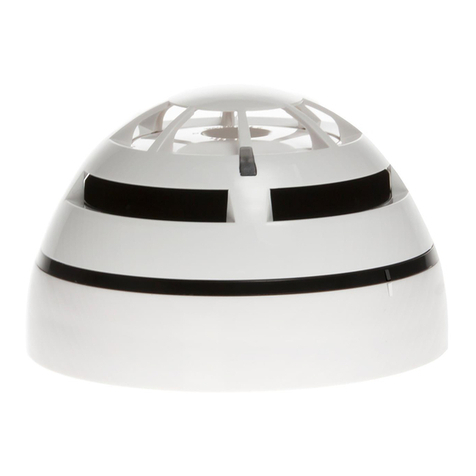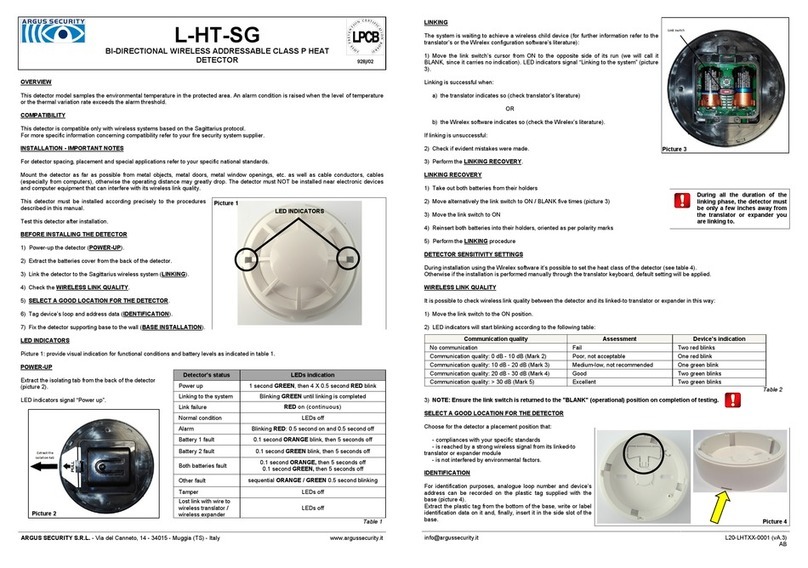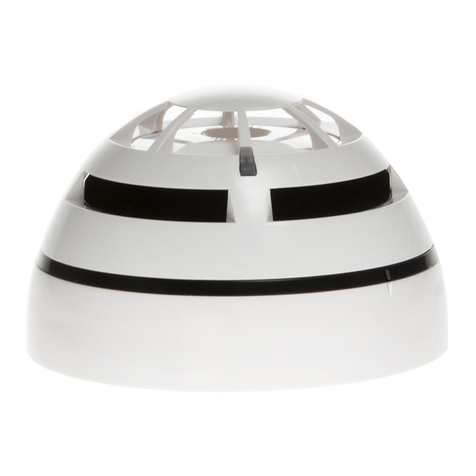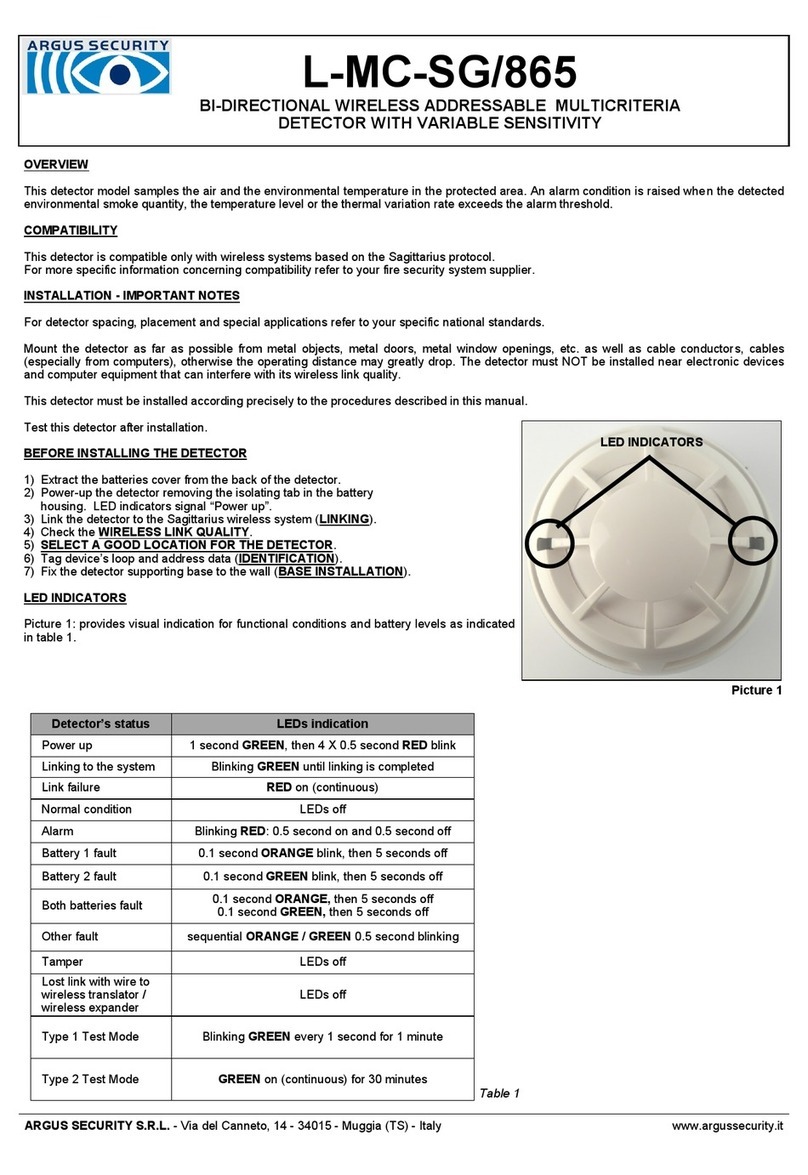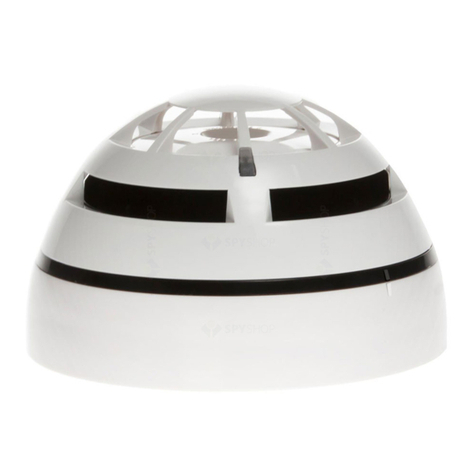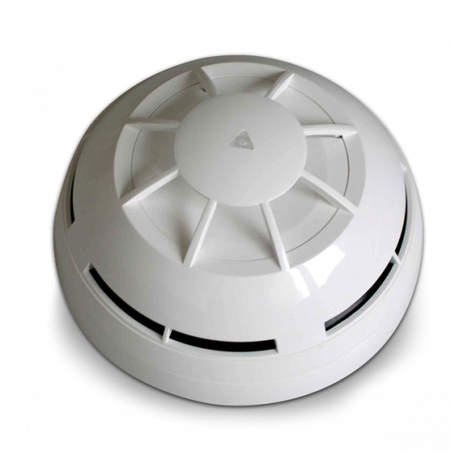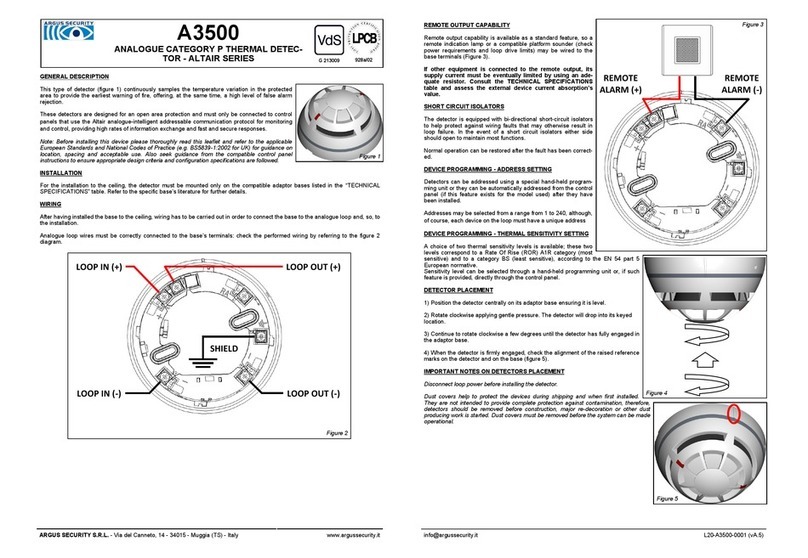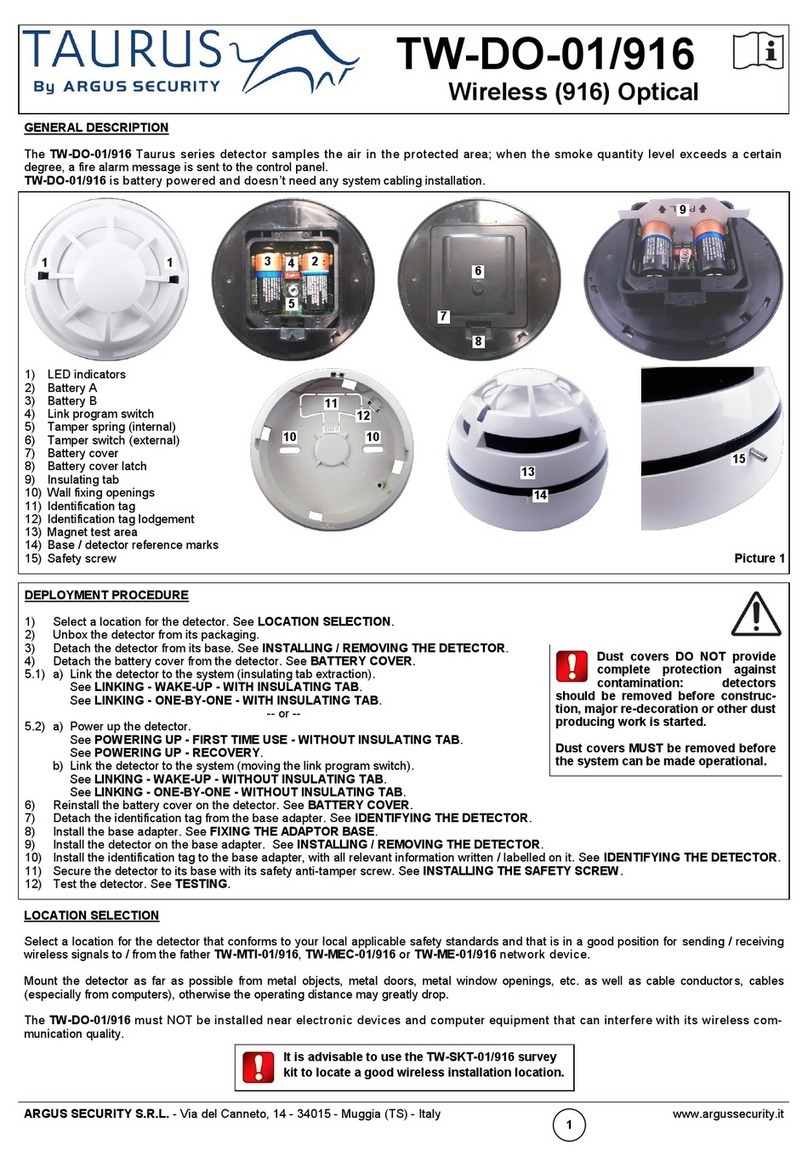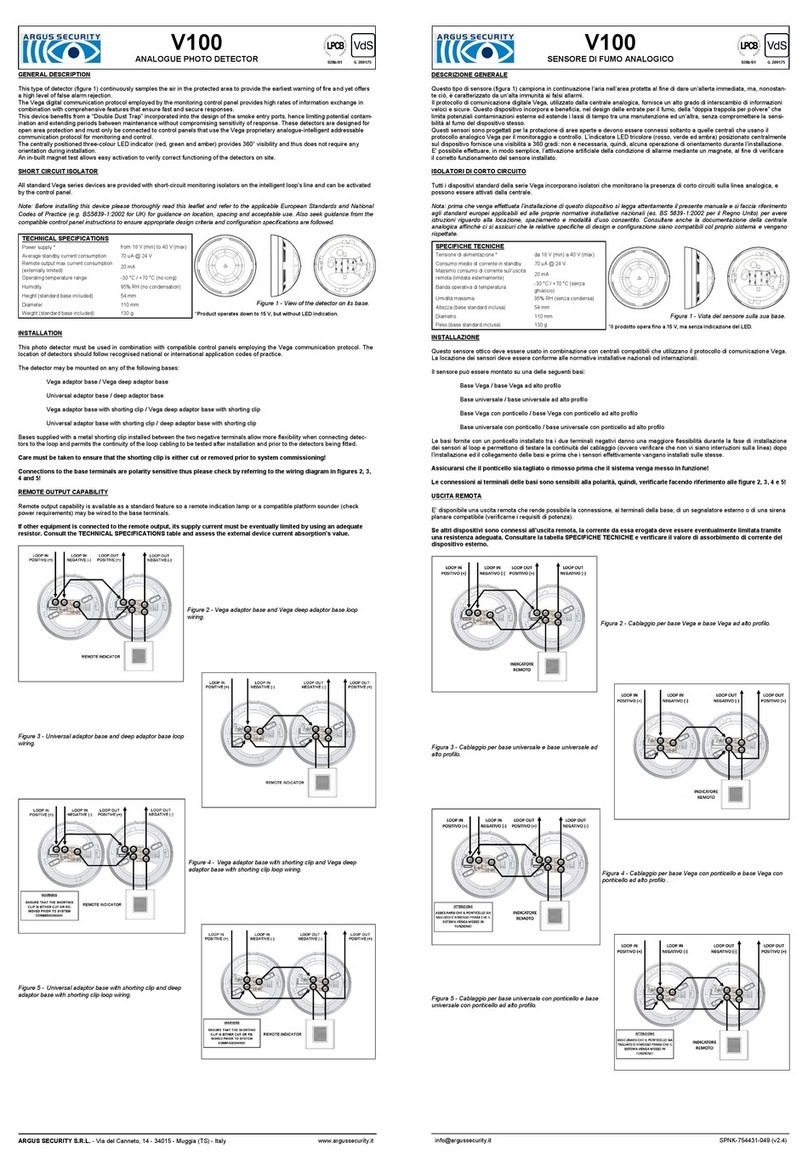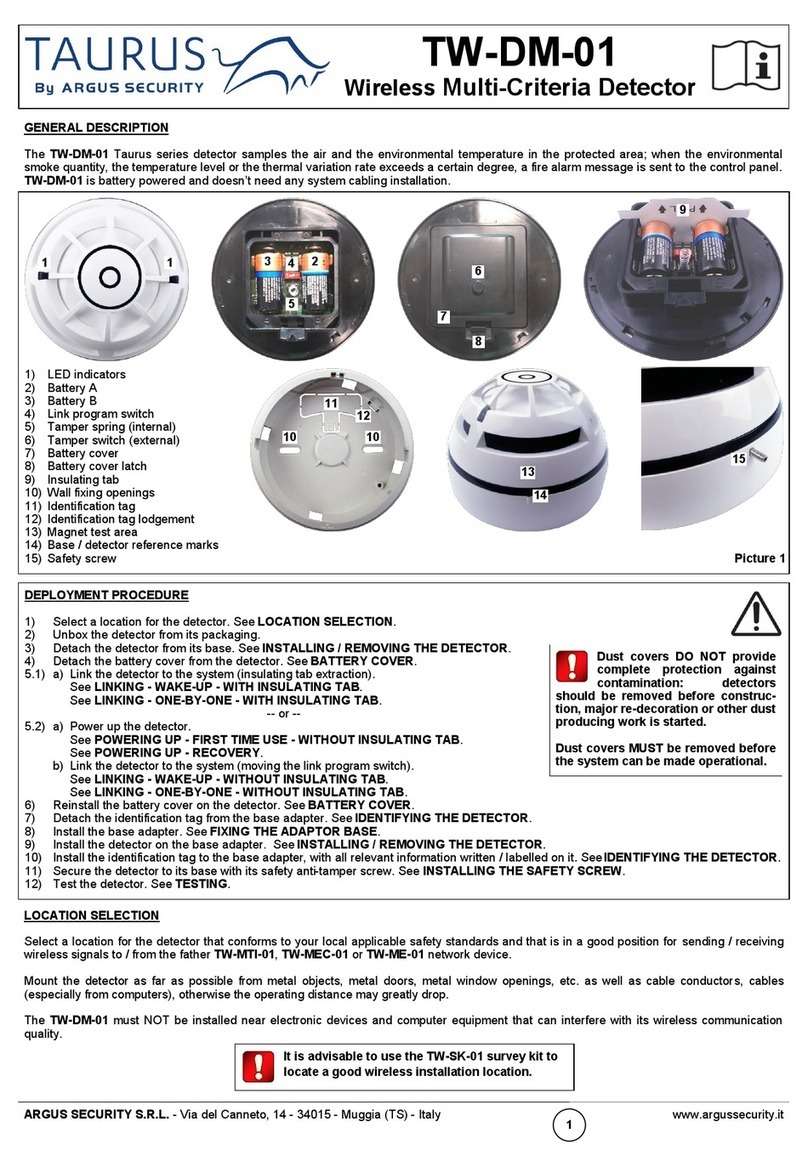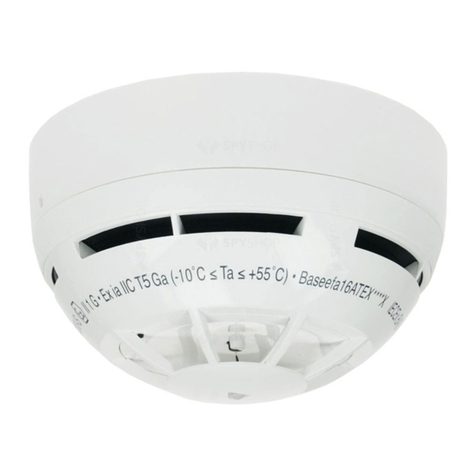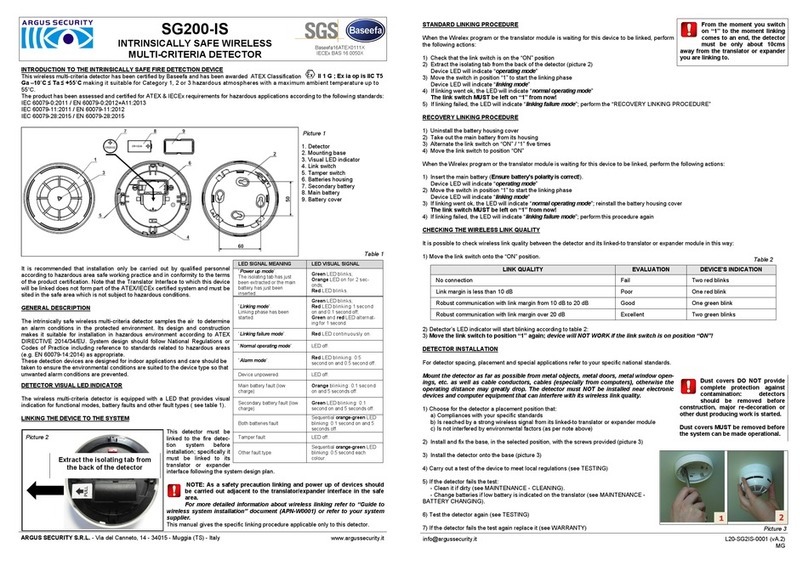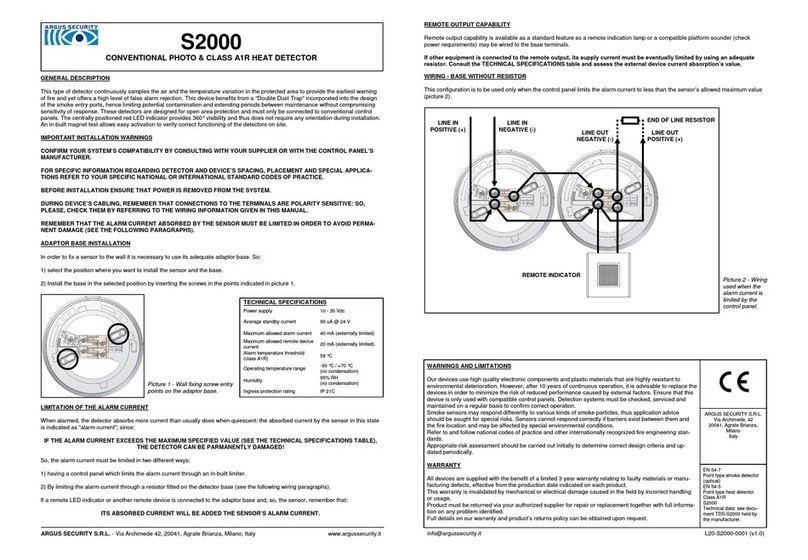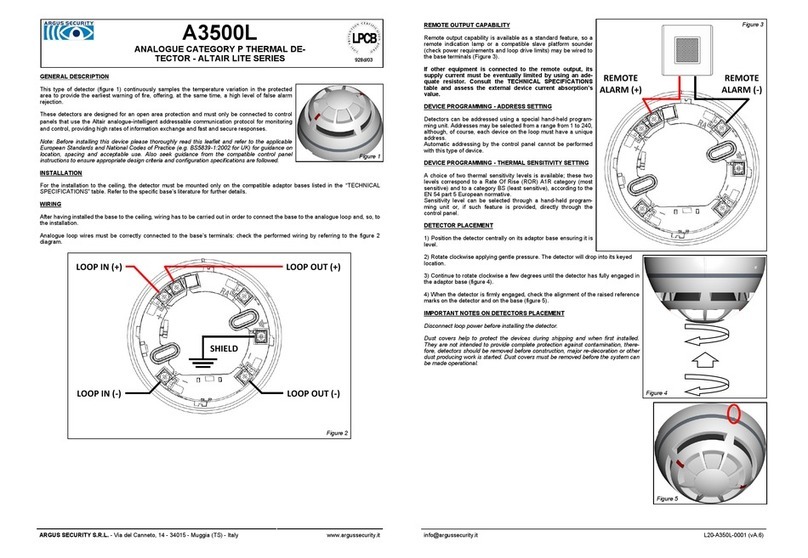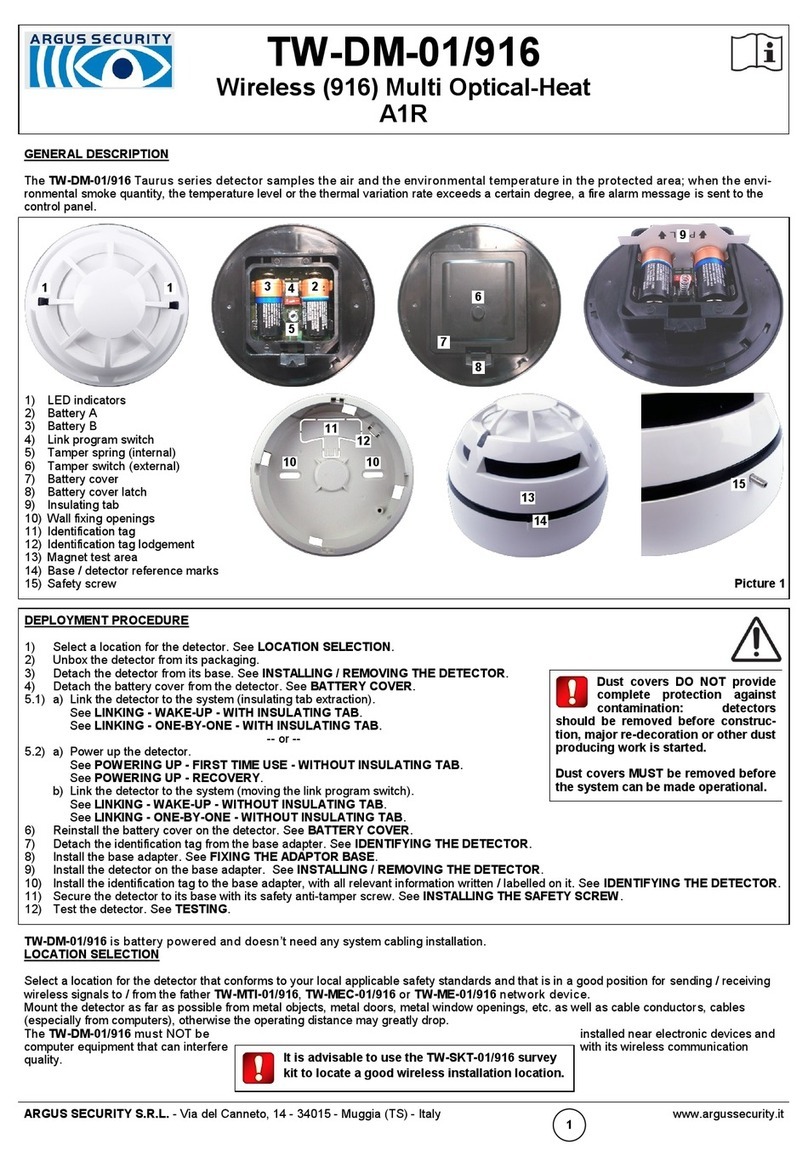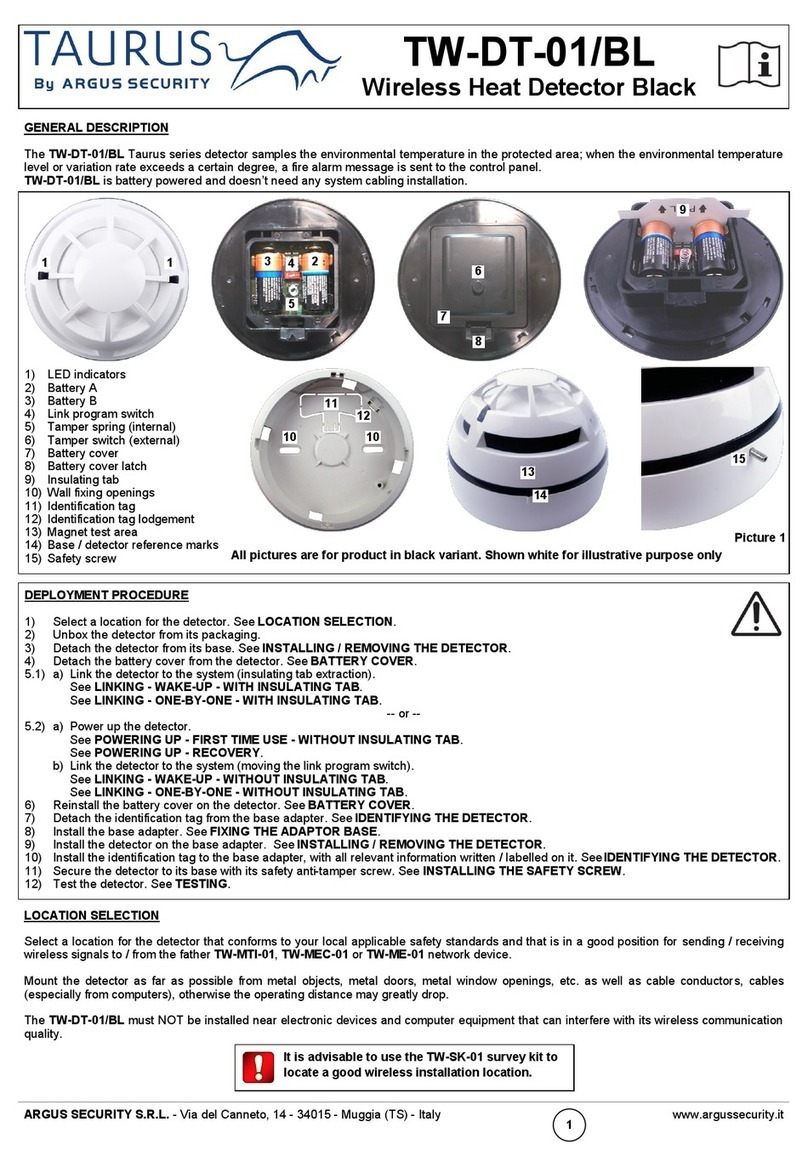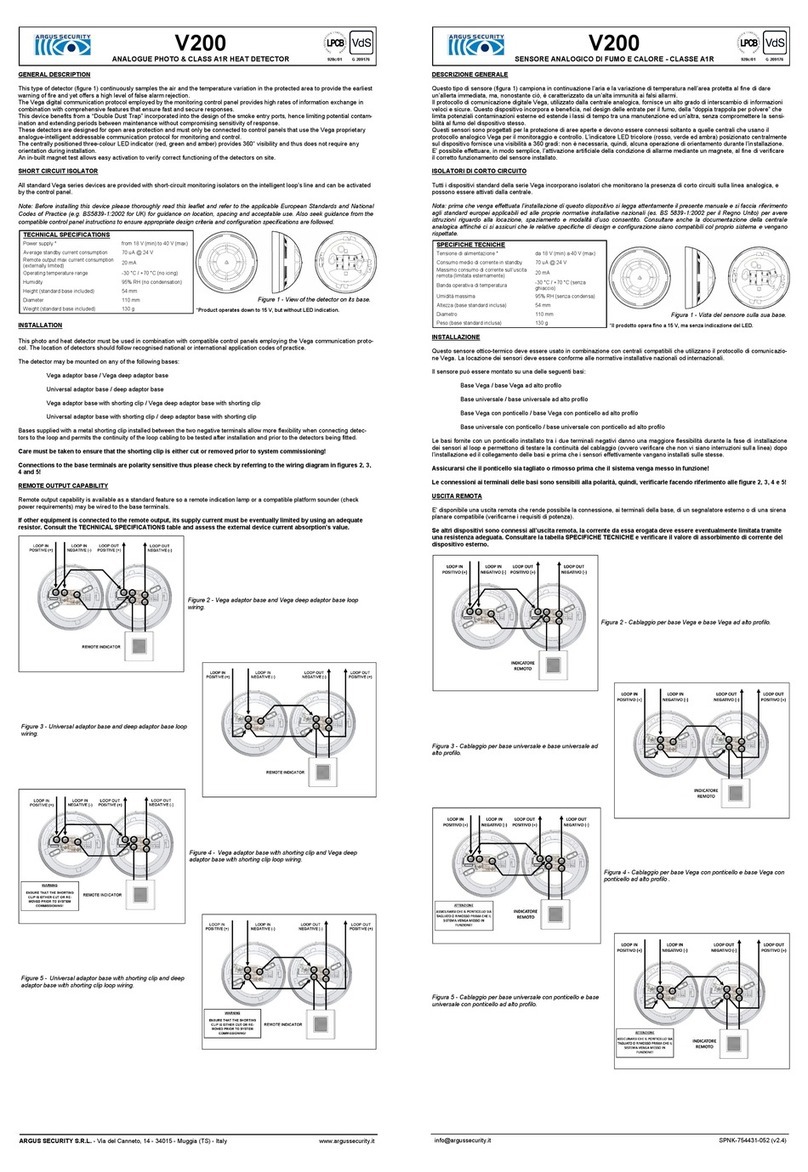HEAT TEST
Use a hair dryer of 1000-1500 W or an heat tool from an approved manufacturer. Direct the heat towards the detector from its side.
Hold the heat source at about 15 cm away from the detector in order to prevent damage to its cover during testing.
The detector should trigger an alarm message to the control panel, and, successively, the detector’s red LEDs should be activated by
the control panel itself.
MAINTENANCE
Before starting any maintenance work, isolate and disable the system in order to avoid accidental and unwanted alarm or fault condi-
tions. Remove the detector from its mounting base to allow inspection in good light at ground level. Inspect the smoke entry ports
around the detector and the thermistor area and use a small, soft bristle brush to dislodge any evident contaminants such as insects,
spider webs, hairs, etc. Use a small vacuum tube or clean, dry and compressed air to suck up or blow away any remaining small
particles from the smoke entry screen area and the thermistor area. Wipe the exterior housing of the detector with a clean, damp, lint
free cloth to remove any surface film that can later attract airborne contaminants. Use the hand-held programming unit to read the
pollution percentage of the chamber; please, refer to the programming unit instruction manual. After all detectors have been inspect-
ed, repositioned on their mounting bases and power has been re-applied, check correct operation by testing the device.
TECHNICAL SPECIFICATIONS **
* Product operates down to 15 V, but without LED indication.
** Further technical data: see document TDS-A200L held by the manufacturer.
WARNINGS AND LIMITATIONS
Our devices use high quality electronic components and plastic materials that are highly
resistant to environmental deterioration. However, after 10 years of continuous operation, it is
advisable to replace the devices in order to minimize the risk of reduced performance caused
by external factors. Ensure that this device is only used with compatible control panels. Detec-
tion systems must be checked, serviced and maintained on a regular basis to confirm correct
operation.
Smoke detectors may respond differently to various kinds of smoke particles, thus application
advice should be sought for special risks. Detectors cannot respond correctly if barriers exist
between them and the fire location and may be affected by special environmental conditions.
Refer to and follow national codes of practice and other internationally recognized fire engi-
neering standards. Appropriate risk assessment should be carried out initially to determine
correct design criteria and updated periodically.
WARRANTY
All devices are supplied with the benefit of a limited 5 years warranty relating to faulty materi-
als or manufacturing defects, effective from the production date indicated on each product.
This warranty is invalidated by mechanical or electrical damage caused in the field by incorrect
handling or usage. Product must be returned via your authorized supplier for repair or replace-
ment together with full information on any problem identified.
Full details on our warranty and product’s returns policy can be obtained upon request.
ANTI -TAMPER DETECTOR LOCK
The detector can be locked to its base as a deterrent to intentional removal performed by non authorized personnel.
Using a cutter, remove the anti-tamper plastic detail, as illustrated in figure 6.
To unlock the detector, insert the tip of a screwdriver into the side slot of the base by exerting only a light pressure (figure 7), and
release the detector by turning it anticlockwise.
LED INDICATORS
This detector is equipped with two red LEDs; their flash pattern indicate the present condition of
the detector itself:
Blinking: indicates the normal operative status of the detector; the performance of this pattern
depends upon the control panel’s model and its settings.
Continuous: indicates an alarmed condition of the detector.
Fault conditions are not indicated by LEDs, but only on the control panel.
Positioning of these LEDs is illustrated in figure 8.
IDENTIFICATION TAB
The adaptor base is equipped with a plastic tab where identification data can be visibly displayed.
Detach the tab from the base; write or label it with the required information, then insert it into its adaptor base’s slot.
TESTING THE DETECTORS - PRELIMINARY NOTE
Detectors should be tested after installation and during periodic maintenance visits; it is recommended each device should be tested
at least once per year.
After each test reset the system and allow at least one minute for power stabilisation.
AEROSOL TEST (SIMULATED SMOKE TEST)
For this test only use test aerosols from an approved manufacturer, in accordance with their application instructions, in order to
prevent contamination or possible damage to the detector. We suggest to spray the aerosol into the detector by using a recommend-
ed applicator. The detector should trigger an alarm message to the control panel, and, successively, the detector’s red LED should
be activated by the control panel itself.
If the detector does not respond to the tests correctly it may be necessary to clean it: in this case follow the instructions indicated in
the “MAINTENANCE” paragraph.
If testing fails again after maintenance then replace the detector with a new one and return the faulty one for servicing.
Figure 8
Power supply *from 18 V (min) to 40 V (max)
Average standby current consumption 55 uA @ 24 V
Remote output max current consumption (externally limited) 20 mA
Compatible adaptor bases LAB1000 - “Low Profile Adaptor Base”
Thermal alarm threshold (ROR A1R category) 58 °C
Operating temperature range -30 °C / +70 °C (no icing)
Humidity 95% RH (no condensation)
ARGUS SECURITY S.R.L.
Via del Canneto, 14
34015 Muggia (TS)
Italy
EN 54-5:2017 + A1:2018
EN 54-7:2018
CEA 4021: July 2003
A2000L
For use in compatible fire detection and
alarm system.
Category A1R
ARGUS SECURITY S.R.L.
- Via del Canneto, 14 - 34015 - Muggia (TS) - Italy www.argussecurity.it [email protected] L20-A200L-0001 (vA.5) Figure 7
Figure 6
Figure 9
2831 0832
14 21
AT5010CPR AT5010UK

